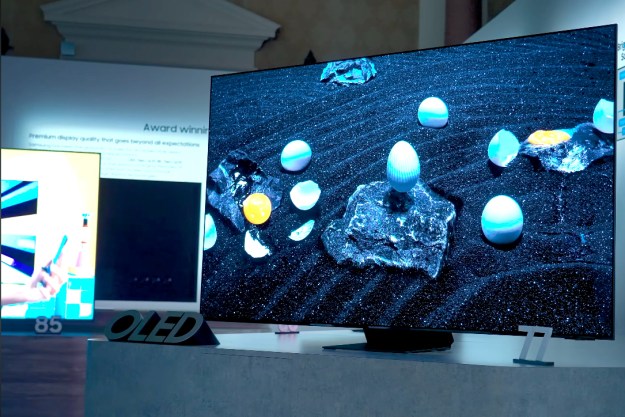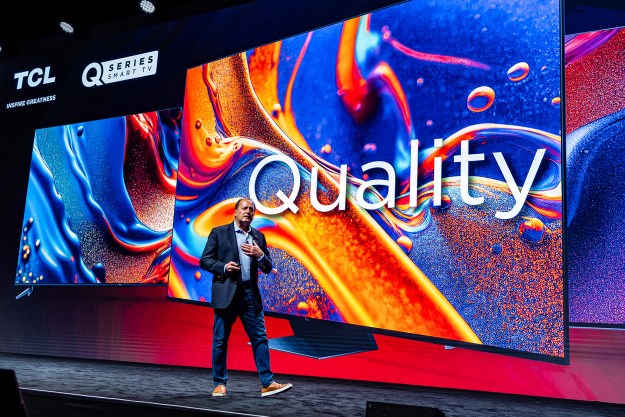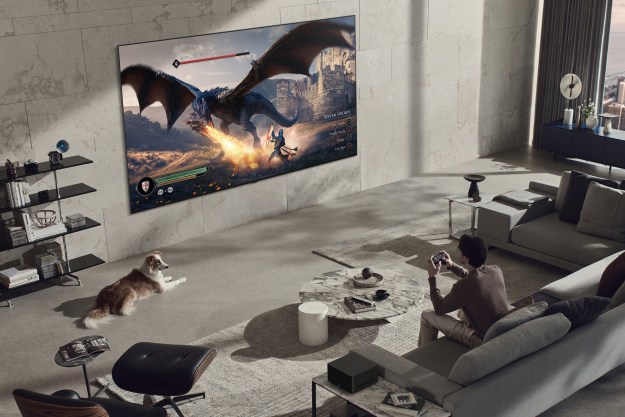Today at the massive IFA show in Berlin, LG will be showcasing an 88-inch 8K OLED TV, available for all show attendees to ogle. And there will be much ogling.
Behind closed doors at CES 2018 in January, we saw an 88-inch 8K OLED display prototype from LG Display, the South Korean electronics company’s business-to-business arm. The massive screen wasn’t available for show attendees to view — it wasn’t even TV at that point. With today’s announcement, we learn LG is one step closer to making such an advanced TV available for purchase most likely in 2019 — with a price tag to match its size.
Sure to generate oohs and aahs by all who pass by, LG’s latest, incredibly large 8K creation sports four times the pixel count of 4K and sixteen times that of standard HDTV. For number crunchers, that’s over 33 million pixels at a 7,680 × 4,320 resolution. Another way to imagine it is four
LG isn’t the only brand bringing 8K to the show, either. We know Samsung will also unveil an 8K QLED TV here at IFA — the billboard advertisements claiming as much are pasted all over Berlin.
Among those not standing enraptured by an 8K image in front of the TV, the arrival of 8K television may not receive such a warm welcome. After all, it seems like we just got 4K TV, and we’ve only just come to the point where

For it’s part, LG has no doubts: The evolution is imminent.
“LG’s first 8K OLED TV is the pinnacle of technological achievement and the next evolutionary step in display technology,” said Brian Kwon, president of LG Home Entertainment Company in a statement about the massive TV. “4K OLED played a major role in reshaping the TV industry, and LG is confident that 8K OLED will do the same.”
Kwon is not wrong. The introduction of 4K OLED was a big step toward inciting a battle for ultra-premium TV supremacy and the rapid development that came with that battle has resulted in a trickle-down effect, bringing ever-improved TV picture quality to prices the average consumer can afford.
Aside from the argument that technology is dying if it isn’t evolving, there’s a proposed benefit to 8K resolution at ultra-large screen sizes. Today’s 65-inch TV is yesterday’s 55-inch TV, and the average TV in living rooms and home theaters is likely to get larger in the coming years. Indeed, LG is betting on it. The company says it expects 8K TV sales to grow to 5 million units by 2022, possibly exceeding the growth of 4K over its first three years.
As for content, the 8K OLED’s onboard upscaling of 4K content should make a considerable difference at 88 inches, and ultimately, 8K content will be here. Live 8K broadcasts are already underway. As for streaming? The bandwidth to support a quality 8K stream is hard to come by, at least in a good portion of the U.S., and would likely eat up bandwidth caps in a hurry. Still, at such sizes, a compressed 8K signal could look superior to today’s
We’ll be getting hands-on time and video of the new 88-inch 8K OLED TV from LG’s booth at IFA 2018 soon, so visit back for a close look at just what this TV brings to the party.
Editors' Recommendations
- Samsung QN900D 8K TV first look: fully loaded flagship
- Samsung’s biggest Neo QLED 8K TV comes with an equally huge price
- Hisense kicks off its U8K mini-LED TV availability with deep discounts
- Samsung takes on TCL with 98-inch 4K TV that costs just $8,000
- LG releases 2023 OLED TV prices: evo G3 starts at $2,500, preorders start March 6




